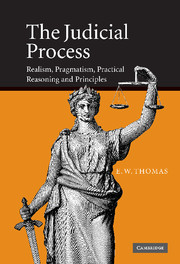Book contents
- Frontmatter
- Contents
- Preface
- 1 Introduction
- 2 Muddling along
- 3 The ‘curse’ of formalism
- 4 Legal fundamentalism
- 5 The idolatry of certainty
- 6 The piety of precedent
- 7 The foibles of precedent – a case study
- 8 There is no impersonal law
- 9 So, what is the law?
- 10 The constraints on the judiciary
- 11 Towards a new judicial methodology
- 12 Of realism and pragmatism
- 13 Of … practical reasoning and principles
- 14 Taking law seriously
- 15 A theory of ameliorative justice
- Subject index
- Authors index
15 - A theory of ameliorative justice
Published online by Cambridge University Press: 15 July 2009
- Frontmatter
- Contents
- Preface
- 1 Introduction
- 2 Muddling along
- 3 The ‘curse’ of formalism
- 4 Legal fundamentalism
- 5 The idolatry of certainty
- 6 The piety of precedent
- 7 The foibles of precedent – a case study
- 8 There is no impersonal law
- 9 So, what is the law?
- 10 The constraints on the judiciary
- 11 Towards a new judicial methodology
- 12 Of realism and pragmatism
- 13 Of … practical reasoning and principles
- 14 Taking law seriously
- 15 A theory of ameliorative justice
- Subject index
- Authors index
Summary
Our Lady of Justice … why the sword?
In her traditional posture, our Lady of Justice stands serenely blindfolded holding a pair of scales in the one hand and a sword in the other. The blindfold denotes that justice is blind to prejudice or pressure. Fearing, no doubt, that justice should not be thought to be also blind to the truth, the blindfold is often discarded in more recent portrayals. The scales are invariably held in an outstretched hand enabling them to perform their balancing faculty. The sword is more mobile. It is sometimes brandished aloft and at other times sheathed within the folds of the good Lady's ample skirt.
We all know why justice is blind. Justice is objective and impartial, administered without fear or favour. She bears no ill will to any litigant, and all are equal before the law. Thus, justice is even-handed. The scales, we also know, symbolize the process by which one value or interest must be balanced against another value or interest to ensure that justice is done. A fair weighting is an irredeemable element in achieving justice.
But, why the sword? A weapon? It seems incongruous that our Lady of Justice should bear arms.
Strangely enough, no one seems to know why the Lady of Justice carries a sword. It could be suggested, I suppose, that the sword confirms that justice is fearless; a warrior in the cause of justice.
- Type
- Chapter
- Information
- The Judicial ProcessRealism, Pragmatism, Practical Reasoning and Principles, pp. 358 - 395Publisher: Cambridge University PressPrint publication year: 2005

